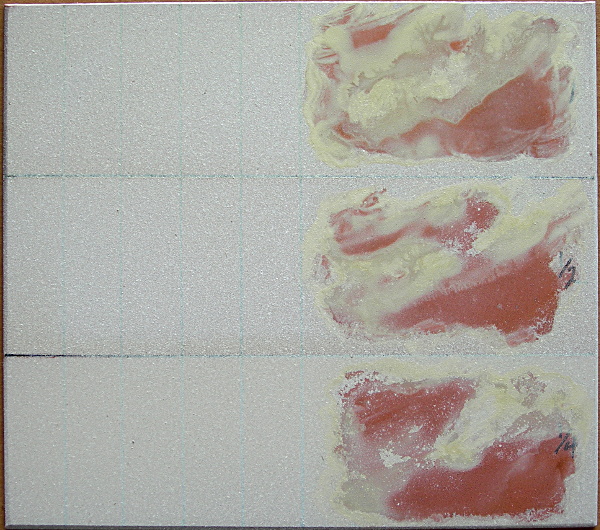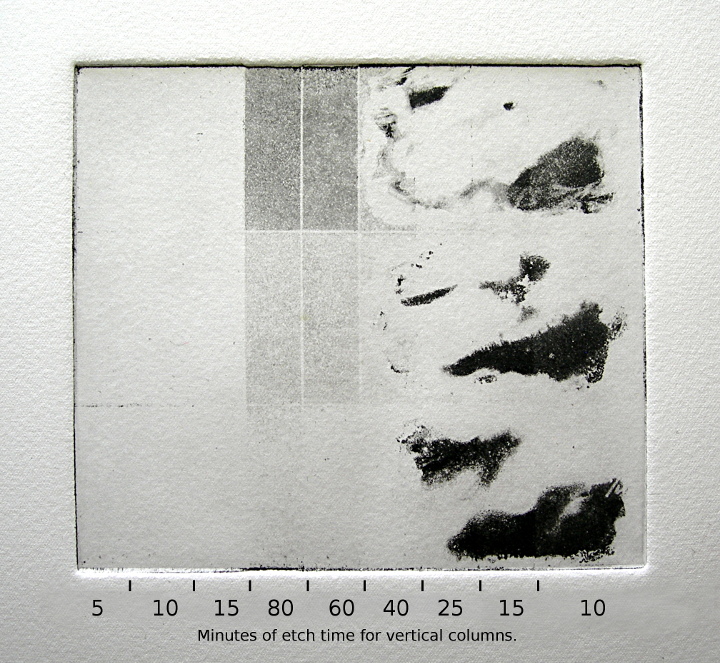| I was asked if it is possible to increase the permeability of Cassara's white ground by putting less linseed oil into the recipe and thereby getting a ground that is equivalent to PG-11. The answer to that, to the best of my knowledge is “no”. While researching for my book (Etching with Permeable Grounds) I experimented very briefly with adding extra titanium dioxide white pigment to the Cassara recipe in the ratio of 1 part white ground to 3 parts (by volume) TiO2 white pigment and noted “Excellent flow, effective binder, dries to slightly harder consistency. Excellent detail. Significant increase in permeability.” By (generously) adding extra TiO2 I was decreasing the relative amount of both the oil and the soap in the recipe, and noted that it increased permeability and still worked well. (Possibly due as much to human psychology as anything else: people may use a thinner coat of something heavily pigmented since it looks the same as a thicker coat of something with less pigment.) At about that time I also experimented with butter in place of linseed oil and decided that I preferred the butter to any of the oils that I had tried up to that point including linseed oil, so focused my experiments on recipes with butter as the oil/grease component. Different oils will impart significantly different characteristics to the grounds made with them. In the introduction to the book, on pg. xi I mentioned “The permeability of PG- 11 is increased by mixing glycerin (available in the health and beauty aid section of most grocery or drug stores) with it. (Surprisingly, this doesn’t seem to work with White Ground.)” I would guess that that is due to the linseed oil combining or reacting differently with glycerin than butter does but I didn't pursue it further. In Cassara's article in “Artist's Proof” regarding his experiments he mentions that “It soon became clear that soap serves as an excellent base; since it has body and is soluble in water, it can be easily distributed to obtain the varying degrees of resistance necessary for the values desired. However, most soaps must be fortified, and though many ingredients can be added, linseed oil is quite adequate for our purpose.” A strictly literal reading of this would suggest that he tried adding a variety of oils (or perhaps other things) to soaps and that some soaps worked without anything added, but not well enough or presumably he wouldn't have turned to linseed oil. The point here is that different oils make significantly different grounds and the differences may not be very consistent or predictable. Having grounds that behave differently is a good thing. It gives etchers choices and what makes one unsuitable for one person's tastes or situation will make it right for another. Nevertheless the question is an interesting one so I recently conducted the following experiment to see what happens with regard to permeability when you decrease the amount of linseed oil in the Cassara recipe. Cassara doesn't specify whether to use raw or boiled linseed oil, Ruth Leaf does specify raw linseed oil. For this experiment I used raw linseed oil. I have never done any experiments to see how raw compares to boiled.
Etchant: 1:1 ferric chloride. (~38 Baume ferric chloride diluted 1:1 with water) No vinegar involved at any time. Grounds were air dried, no heat applied except slight warming from a hair-dryer. No grounds dried overnight. Grounds were applied on top of a box rosin aquatint.
I mixed the three grounds in separate batches on a glass slab and mulled them with an electric drill as described in EWPG, using one teaspoon as the volume. Also since granular Ivory Snow is no longer available, I used ground up bars of Ivory soap (as described on pg. 168 of the book) and at half the volume called for in Cassara's recipe since ground up bars weigh twice as much per volume as Ivory Snow. So the first batch had 1 tsp. of linseed oil; 2 tsp. titanium dioxide white pigment, 2 tsp. Ivory soap, and water as necessary. The second batch had the same except for ½ tsp. of linseed oil and ¼ tsp. linseed oil for the third batch. As I finished mixing and mulling each batch I put it in a labeled plastic cup with a snap-on lid. Similarly, I prepared three more labeled cups with the three grounds diluted at 1 part ground to 4 parts water for use with the airbrush. The plate was then divided vertically into 6 columns: (see above illustration) five columns ½ inch wide on the left and one column 2 ½ inches wide on the right. I wanted to test both the permeability and the handling and tonal transitions of the three grounds so the five columns on the left were to show just the permeation of the etchant through a uniform flat coat of the three grounds at different amounts of etch time, and the panel on the right would show a washy image with varying thicknesses of ground that would show the handling and tonal transitions. I then airbrushed (as accurately as I could) equal even coatings of ground on each of the three respective horizontal panels. I had demarcated the panels and columns with a sharpie pen, and airbrushed on ground in an even layer just thick (or thin) enough that I was still able to make out the underlying lines. I then scrubbed in the coating of ground on the right side of the plate with a brush and some water to create the washy imagery.
As the etching progressed it looked to me like very little was happening on the left side of the plate, but on the right side where some of the aquatint had been completely exposed the ferric chloride was etching the copper fairly quickly. I wanted to leave it in long enough to at least have something, however slight, happen on the left panels without radically over-biting the right side so I started stopping out the right side progressively with a one-inch vertical column on the extreme right plate and three ½ inch columns moving toward the center of the plate. I had originally planned to leave the plate in the etchant for a single 20-minute bite but ended up with seven timed bites, the longest one for 80 minutes. The big shock came when I cleaned the plate and saw that not only had I gotten visible results on the left half of the plate but the results were exactly the opposite of what I and (I think) any other etcher would have expected. That is that the reduction of linseed oil in the recipe made the ground less, not more permeable. So until somebody explains to me what I got backwards, I would say if you're trying to increase the permeability of Cassara's white ground, don't do it by putting less linseed oil in it. I don't know what would happen if you put more linseed oil in it, I suppose the oil would separate out unless you also put more soap in to emulsify it. According to the results of this experiment, that would be the way to make the ground more permeable. Maybe somebody will try it and let me know. If anyone sends me additional information I will be happy to post it here. I didn't notice much difference in the handling characteristics and tonal transitions for the three versions of the ground. All seemed to have a high degree of contrast. As noted in the second paragraph above, adding a large amount of pigment to Cassara's recipe did seem to increase permeability. I would suggest that to boost the permeability of Cassara's white ground one should add pigment to it until the performance of the ground starts to suffer. At some point the ground will take on a sedimentary character and get too chalky and adhere poorly to the plate. PG-11 is just Cassara's recipe with butter substituted for linseed oil and way more pigment added. Cassara's recipe has about a 1:6 ratio of oil to combined soap and pigment (1:4 if you use the soap as I do) and PG-11 has about a 1:16 ratio of butter to combined soap and pigment. I haven't really explored the role of the soap in this; I think of it as something to emulsify the oil but it may have a more active role than that. Like many experiments, this one offers more questions than answers. There would also be questions about its use as an adhesive, wet-in-wet and as a soft ground.
|


